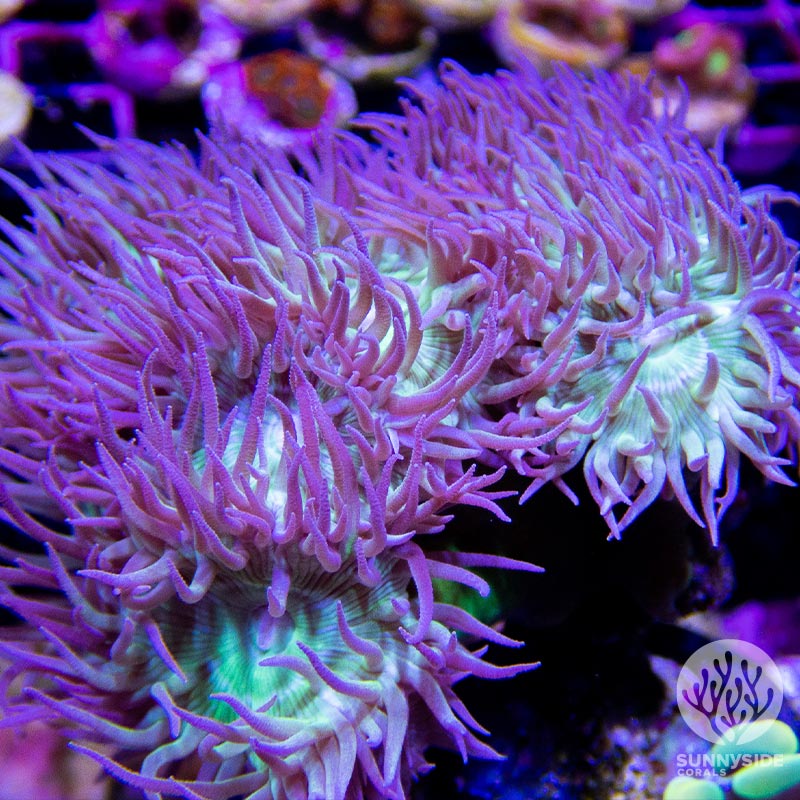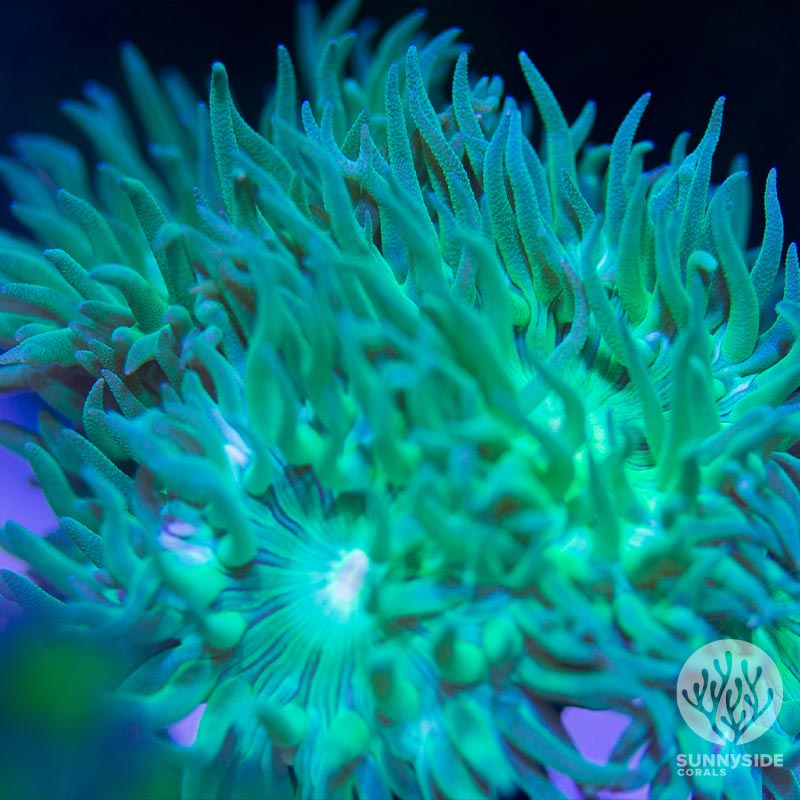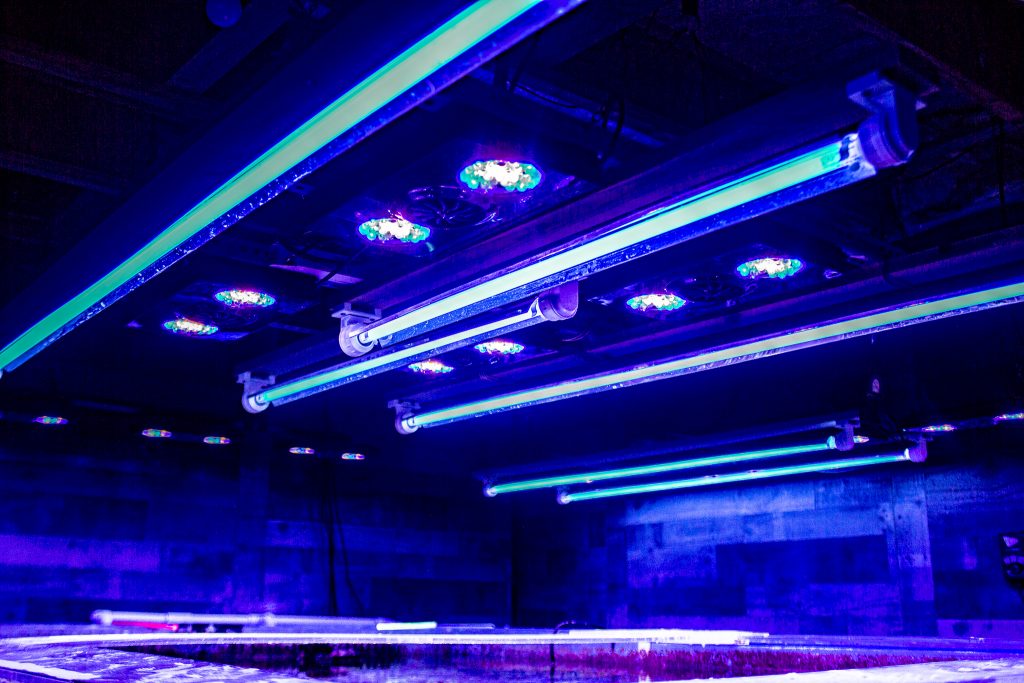Duncan Coral Care Overview:
Common Name: Duncan Coral, Whisker Coral
Latin Name: Duncanopsammia axifuga
Difficulty Level: Beginner
Colors: Green, Blue, Purple/Pink
Temperament: Peaceful. They pose little threat to other corals or tank-mates. Simply give these corals space for growth.
Growth Speed: Medium – Fast. Duncans can be fed brine or mysis shrimp weekly to increase their growth rates.
Tank Placement: Middle to lower part of the tank, including the sand bed.
Lighting Intensity: Medium to High. Around 100 PAR is a great starting point for many duncans.
Water Flow: Moderate (indirect flow) Their polyps should wave gently without being slammed by flow, as too much direct flow can cause tissue damage or hinder food capture.
Temperature: 78°F / 25.5°C, though they can adapt to temperatures as low as 77°F and as high as 84°F. We keep all of our tanks at 78°F
pH: 8.1-8.4, ideally around 8.2-8.3.
Nitrate: 5-10 ppm, keeping levels stable.
Phosphate: 0.05-0.1 ppm, keeping levels stable.
Alkalinity: 9 dKh
More About Duncan Corals
Duncanopsammia axifuga, also known as Duncanops coral, or Duncan corals, are a popular choice for beginner reef keepers due to their ease of care and striking appearance. These types of corals are named after their fleshy feather-like polyps, and they come in a variety of colors, including blue, green, and purple. While they are easy to care for, you’ll want to understand their specific needs to ensure they thrive in your reef tank.
What is Duncan Coral?
Duncan coral is a species of LPS (large-polyp stony coral) that originates from the Indo-Pacific region. It is a popular choice among reef aquarium enthusiasts due to its beautiful appearance and relatively easy care requirements. If you are looking for an easy coral that will add nice movement to your tank, Duncans are perfect!
These stony corals have a distinctive appearance, with long, flowing purple, pink, or green tentacles that resemble feathers. The coral’s skeleton is hard and calcareous, and can be white or brown in color.
One of the unique features of Duncan coral is that it is a colonial species, meaning that it is made up of many individual polyps that share a common skeleton. Each polyp has its own tentacles and mouth, but they all work together to form a larger colony.


Duncan Coral Care

Tank Requirements
One of the most important factors in caring for Duncan corals is their placement in the tank. They prefer areas of moderate water movement, making the middle to lower part of the tank an ideal location. We recommend placing them directly in the sand bed or on live rock in the lower-light, slower water flow areas of the tank.
When attaching Duncan corals to rock, we often use superglue gel. If you choose this option, remember to always use the gel type or it won’t stick!
Lighting and Water Flow
Duncan coral requires moderate to high lighting levels. Provide them with 8-10 hours of light per day. For more help on lighting, you can see our exact light set up and schedules on our tank lighting post.
These corals need good flow and should be placed in a medium to high current. This is because they are very susceptible to being taken over by algae and other organisms if there is not enough flow.
Water Parameters
Another crucial aspect of Duncan coral care is maintaining proper water chemistry. These corals require medium alkalinity of 9dKh. Alkalinity is crucial to growth, so it’s important to keep minimal fluctuations. By understanding these basic care requirements, you can ensure that your Duncan corals thrive in your reef tank and bring a beautiful pop of color to your underwater world.
The ideal water temperature for Duncan coral is 78 degrees Fahrenheit. They thrive the best with a medium flow of water that gives them a “light breeze.” Your pH should be maintained between 8.1 and 8.4, and the salinity should be 1.025. Duncans do best with stable nitrate levels between 5-10 ppm and phosphate levels around 0.05-0.1 ppm.
Feeding and Nutrition
Duncan coral is photosynthetic and receives most of its nutrition from the zooxanthellae living inside its tissue. It also feeds on small particulate matter and plankton in the water column.
In general, Duncans don’t need to be fed, but you can target feed them or simply broad-feed the fish in your tank to increase their growth rates. They can be fed a variety of foods, including nauplii larvae, brine shrimp, copepods, and mysis. We typically broad-feed our whole tank with brine shrimp, mysis shrimp, and other frozen foods once a week
Propagation and Fragging
Duncan coral can be propagated by fragging. Fragging is the process of cutting a small piece of coral and then attaching it to a new surface to grow. It is important to use a sharp, sterile tool and to cut the coral at the base of the polyp. Allow the frag to heal for a few weeks before moving it to a new location.
Common Issues and Solutions
Losing Coral Heads: Like many corals (and humans), duncans can lose their heads when conditions are less than ideal. Too much water flow, changes in water chemistry, or lighting issues can all contribute to the problem. If your duncan is losing heads, confirm that the basics in those three areas are covered.
Algae Growth: Excessive algae growth can occur with low water flow. Address this by increasing water flow and reducing key nutrient levels in the tank.
Bleaching: Bleaching is caused by stress from changes in water temperature, lighting, or water chemistry. To prevent bleaching, maintain stable water parameters and avoid sudden changes.
Get Started With Duncan Corals
Overall, Duncan Corals are a great choice for beginner reef keepers or anyone looking to add a colorful and easy-to-care-for coral to their tank. With proper care and attention, your Duncan coral will thrive and add beauty to your tank for years to come.
Ready to get started? Check out our cut-to-order duncan corals.
FAQ Section
Are Duncan Coral easy to keep?
Duncan corals are generally considered to be easy to keep in a reef aquarium. They are hardy and can adapt to a range of water conditions. However, it is important to note that they do require proper care and attention to thrive.
Are Duncan Corals Aggressive?
No, Duncans are considered peaceful corals and make great additions to any coral tank.
Where do you put Duncan Coral in a tank?
The ideal placement for Duncan corals is towards the bottom of the tank, even in the sand bed in the medium light, medium water flow areas of the tank.
Are Duncan corals hardy?
Duncan corals are generally considered to be hardy and can adapt to a range of water conditions. However, they are still living creatures and can be impacted by changes in water parameters or other stressors in the tank.
How do you take care of a Duncan Coral?
Proper care for Duncan corals includes providing them with the right water parameters, including stable temperature, pH, and salinity levels. They also need moderate lighting and low to moderate water flow. It is important to maintain good water quality and perform regular water changes to keep the tank environment healthy for the coral. Additionally, feeding the coral regularly with small pieces of meaty foods can help promote growth and health.
